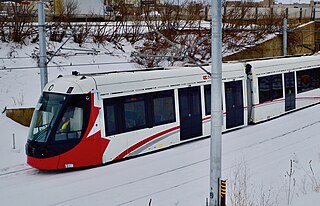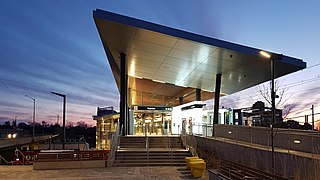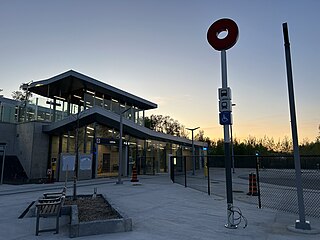
OC Transpo is the primary public transport agency for the city of Ottawa, Ontario, Canada, operating bus rapid transit, light rail, conventional bus routes, and door-to-door paratransit in the nation's capital region.

The Transitway is a bus rapid transit (BRT) network operated by OC Transpo in Ottawa, Ontario, Canada. It comprises a series of bus-only roadways and reserved lanes on city streets and highways. The dedicated busways ensure that buses and emergency vehicles on the Transitway rarely intersect directly with regular traffic, making it possible to run quickly and consistently, even during rush hour traffic. OC Transpo operates a network of rapid routes which use the Transitway to connect communities with the O-Train light rail system. Additional bus routes also use segments of the Transitway.

Bayview is an O-Train interchange station in Ottawa, Ontario, Canada, connecting the Confederation Line and Trillium Line.

Greenboro is a transitway stop and O-Train Trillium Line station in Ottawa, Ontario, Canada. It is located at Bank Street and Johnston Road at the north end of the South Keys shopping complex. The station has a 678-space paid park and ride lot. The bus terminus was opened with the southern transitway on September 2, 1995.

Carleton is an O-Train light rail station located in the center of the Carleton University campus in Ottawa, Ontario. The station is served by Line 2, which began service in 2001, and is between Dow's Lake station to the north and Mooney's Bay station to the south. Along with the rest of the Trillium Line, the station closed on May 3, 2020, for the extension of the line and an upgrade of the station. The station re-opened on January 6, 2025.
The Chief William Commanda Bridge, formerly the Prince of Wales Bridge, is a pedestrian/cycling bridge and former rail bridge that spans the Ottawa River between Ottawa, Ontario and Gatineau, Quebec, Canada. It connects the Trillium Pathway in Ottawa to the Voyageurs Pathway in Gatineau. The bridge crosses the south channel of the river to Lemieux Island at the edge of Nepean Bay and continues across the northern channel into the Province of Quebec.

South Keys station is an O-Train station and the southernmost station of the Southeast Transitway in Ottawa. The station is located in the South Keys neighbourhood, behind the south end of the South Keys Shopping Centre, and between Bank Street and the Airport Parkway. The Transitway station was opened for bus service on September 2, 1995.

Walkley is an intermodal OC Transpo station in Ottawa, Ontario. It is located in on Walkley Road between Airport Parkway and Bank Street. There are plans for mixed-use development all around the station which is vacant.

Place d'Orléans is a transitway station in the suburb of Orléans in the former city of Gloucester in Ottawa, Ontario, Canada. The station opened in 1994, just off Regional Road 174 and Champlain Street right next to Place d'Orléans Shopping Centre. It is the main transit hub between local routes in Orléans and route 39.

Airport is an O-Train rapid transit station. It is located at Ottawa Macdonald–Cartier International Airport in the south end of Ottawa. It serves as the southwestern terminus of the three-stop Line 4 which opened on January 6, 2025. The airport is also served by an OC Transpo bus stop.

Light rail is a commonly used mode of public transit in North America. The term light rail was coined in 1972 by the Urban Mass Transportation Administration to describe new streetcar transformations which were taking place in Europe and the United States. The Germans used the term Stadtbahn, which is the predecessor to North American light rail, to describe the concept, and many in UMTA wanted to adopt the direct translation, which is city rail. However, in its reports, UMTA finally adopted the term light rail instead.

Jeanne d'Arc station is a stop on Ottawa's Transitway and future O-Train station. It is located at the interchange of Regional Road 174 and Jeanne d'Arc Boulevard in Orléans in the east end of the city of Ottawa.

Leitrim is a station on the Trillium Line of Ottawa's O-Train and on the system's bus network, and is located in the suburban community of Leitrim. Situated on Gilligan Road, it serves as a transportation hub connecting residents to downtown Ottawa and other parts of the city. Leitrim station opened on January 6, 2025, as part of Ottawa's extensive Stage 2 transit expansion project.

The Confederation Line, also called O-Train Line 1, is a urban rail line operated by OC Transpo in Ottawa, Ontario, Canada, as part of the city's O-Train system. It opened on September 14, 2019, and is O-Train's second line. It operates on an east–west route, with a segment under Queen Street in the downtown core, complementing the north–south Trillium Line that operates to the west of the downtown core. Despite using light rail rolling stock and technology, the Confederation Line is completely grade separated. Having full grade separation and CBTC train control, this line can be categorised as a light metro.

The O-Train is a light rail system in Ottawa, Ontario, Canada, operated by OC Transpo. The system consists of three lines: the electrically-operated Confederation Line, running east to west; and the diesel-operated Trillium Line, running north to south, as well as the Airport Link. Line 1 is currently being extended as part of the Stage 2 project, with new segments being phased in between 2025 and 2027.

The Alstom Citadis Spirit is a low-floor articulated light rail vehicle developed by Alstom for Ottawa's O-Train. It is marketed as part of its Citadis family, which includes other models of light rail vehicles, and is based on the Citadis Dualis.

Corso Italia is an infill station on the Trillium Line in Ottawa, Ontario. It services Ottawa's Little Italy neighbourhood. It was constructed as part of the Stage 2 O-Train expansion and opened on January 6, 2025, along with the rest of the reopened Trillium Line, which closed on May 3, 2020, for the extension of the line. The station has two side platforms and is located north of Gladstone Avenue, near Preston Street.

Limebank is the terminal station on the Trillium Line in Ottawa, Ontario. The station is elevated with two side platforms and is located southwest of the intersection of Limebank and Earl Armstrong roads. OC Transpo Rapid bus routes 74 and 99 connect to this station with revenue service which began January 6, 2025.
The O-Train Line 4, also known as the Airport Link, is a diesel light rail line on the O-Train network in Ottawa, Ontario. The line provides a connection between the Trillium Line at South Keys station to the Ottawa Macdonald–Cartier International Airport. The four-kilometre (2.5 mi) line opened on January 6, 2025.





























